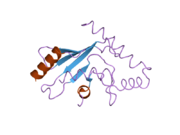Biology:CDC34
From HandWiki
Short description: Protein-coding gene in the species Homo sapiens
 Generic protein structure example |
CDC34 is a gene that in humans encodes the protein Ubiquitin-conjugating enzyme E2 R1.[1][2][3] This protein is a member of the ubiquitin-conjugating enzyme family, which catalyzes the covalent attachment of ubiquitin to other proteins.[4]
CDC34 was originally discovered by work in baker's yeast as a gene that is essential for the cell cycle.[5] Cdc34 in yeast targets numerous substrates - notably the cyclin-dependent kinase inhibitor Sic1[6] - for ubiquitin-mediated protein degradation.[7] CDC34 is required for ubiquitin-mediated degradation of cell cycle G1 regulators, and for the initiation of DNA replication.[3]
Interactions
CDC34 has been shown to interact with CSNK2B,[8] BTRC[9][10] and CDK9.[11]
References
- ↑ "Cloning of the human homolog of the CDC34 cell cycle gene by complementation in yeast". Proceedings of the National Academy of Sciences of the United States of America 90 (22): 10484–8. November 1993. doi:10.1073/pnas.90.22.10484. PMID 8248134. Bibcode: 1993PNAS...9010484P.
- ↑ "Proximity-induced activation of human Cdc34 through heterologous dimerization". Proceedings of the National Academy of Sciences of the United States of America 102 (42): 15053–8. October 2005. doi:10.1073/pnas.0507646102. PMID 16210246. Bibcode: 2005PNAS..10215053G.
- ↑ 3.0 3.1 "Entrez Gene: CDC34 cell division cycle 34 homolog (S. cerevisiae)". https://www.ncbi.nlm.nih.gov/sites/entrez?Db=gene&Cmd=ShowDetailView&TermToSearch=997.
- ↑ "The yeast cell cycle gene CDC34 encodes a ubiquitin-conjugating enzyme". Science 241 (4871): 1331–5. September 1988. doi:10.1126/science.2842867. PMID 2842867. Bibcode: 1988Sci...241.1331G.
- ↑ "The role of S. cerevisiae cell division cycle genes in nuclear fusion". Genetics 100 (2): 175–84. February 1982. doi:10.1093/genetics/100.2.175. PMID 7049831.
- ↑ "How proteolysis drives the cell cycle". Science 274 (5293): 1652–9. December 1996. doi:10.1126/science.274.5293.1652. PMID 8939846. Bibcode: 1996Sci...274.1652K.
- ↑ "Structural insights into E1 recognition and the ubiquitin-conjugating activity of the E2 enzyme Cdc34". Nature Communications 10 (1): 3296. July 2019. doi:10.1038/s41467-019-11061-8. PMID 31341161. Bibcode: 2019NatCo..10.3296W.
- ↑ "Phosphorylation of the human ubiquitin-conjugating enzyme, CDC34, by casein kinase 2". The Journal of Biological Chemistry 276 (44): 41049–58. November 2001. doi:10.1074/jbc.M106453200. PMID 11546811.
- ↑ "CK2-dependent phosphorylation of the E2 ubiquitin conjugating enzyme UBC3B induces its interaction with beta-TrCP and enhances beta-catenin degradation". Oncogene 21 (25): 3978–87. June 2002. doi:10.1038/sj.onc.1205574. PMID 12037680.
- ↑ "Identification of a family of human F-box proteins". Current Biology 9 (20): 1177–9. October 1999. doi:10.1016/S0960-9822(00)80020-2. PMID 10531035.
- ↑ "Interaction between cyclin T1 and SCF(SKP2) targets CDK9 for ubiquitination and degradation by the proteasome". Molecular and Cellular Biology 21 (23): 7956–70. December 2001. doi:10.1128/MCB.21.23.7956-7970.2001. PMID 11689688.
External links
- Human CDC34 genome location and CDC34 gene details page in the UCSC Genome Browser.
Further reading
- "How proteolysis drives the cell cycle". Science 274 (5293): 1652–9. December 1996. doi:10.1126/science.274.5293.1652. PMID 8939846. Bibcode: 1996Sci...274.1652K.
- "Cell cycle regulation by the ubiquitin pathway". FASEB Journal 11 (13): 1067–75. November 1997. doi:10.1096/fasebj.11.13.9367342. PMID 9367342.
- "Association of human CUL-1 and ubiquitin-conjugating enzyme CDC34 with the F-box protein p45(SKP2): evidence for evolutionary conservation in the subunit composition of the CDC34-SCF pathway". The EMBO Journal 17 (2): 368–83. January 1998. doi:10.1093/emboj/17.2.368. PMID 9430629.
- "Phosphorylation of nuclear MyoD is required for its rapid degradation". Molecular and Cellular Biology 18 (9): 4994–9. September 1998. doi:10.1128/mcb.18.9.4994. PMID 9710583.
- "Identification of the ubiquitin carrier proteins, E2s, involved in signal-induced conjugation and subsequent degradation of IkappaBalpha". The Journal of Biological Chemistry 274 (21): 14823–30. May 1999. doi:10.1074/jbc.274.21.14823. PMID 10329681.
- "Human Cdc34 and Rad6B ubiquitin-conjugating enzymes target repressors of cyclic AMP-induced transcription for proteolysis". Molecular and Cellular Biology 19 (7): 5001–13. July 1999. doi:10.1128/mcb.19.7.5001. PMID 10373550.
- "Cdc53/cullin and the essential Hrt1 RING-H2 subunit of SCF define a ubiquitin ligase module that activates the E2 enzyme Cdc34". Genes & Development 13 (12): 1614–26. June 1999. doi:10.1101/gad.13.12.1614. PMID 10385629.
- "Nedd8 modification of cul-1 activates SCF(beta(TrCP))-dependent ubiquitination of IkappaBalpha". Molecular and Cellular Biology 20 (7): 2326–33. April 2000. doi:10.1128/MCB.20.7.2326-2333.2000. PMID 10713156.
- "Association of human ubiquitin-conjugating enzyme CDC34 with the mitotic spindle in anaphase". Journal of Cell Science 113 ( Pt 10) (10): 1687–94. May 2000. doi:10.1242/jcs.113.10.1687. PMID 10769200.
- "Degradation of B-Myb by ubiquitin-mediated proteolysis: involvement of the Cdc34-SCF(p45Skp2) pathway". Oncogene 19 (26): 2986–95. June 2000. doi:10.1038/sj.onc.1203618. PMID 10871850.
- "SCF(beta-TRCP) and phosphorylation dependent ubiquitinationof I kappa B alpha catalyzed by Ubc3 and Ubc4". Oncogene 19 (31): 3529–36. July 2000. doi:10.1038/sj.onc.1203647. PMID 10918611.
- "Cloning and characterization of AWP1, a novel protein that associates with serine/threonine kinase PRK1 in vivo". Gene 256 (1–2): 113–21. October 2000. doi:10.1016/S0378-1119(00)00365-6. PMID 11054541.
- "Phosphorylation of the human ubiquitin-conjugating enzyme, CDC34, by casein kinase 2". The Journal of Biological Chemistry 276 (44): 41049–58. November 2001. doi:10.1074/jbc.M106453200. PMID 11546811.
- "The Nedd8-conjugated ROC1-CUL1 core ubiquitin ligase utilizes Nedd8 charged surface residues for efficient polyubiquitin chain assembly catalyzed by Cdc34". The Journal of Biological Chemistry 277 (1): 516–27. January 2002. doi:10.1074/jbc.M108008200. PMID 11675391.
- "Interaction between cyclin T1 and SCF(SKP2) targets CDK9 for ubiquitination and degradation by the proteasome". Molecular and Cellular Biology 21 (23): 7956–70. December 2001. doi:10.1128/MCB.21.23.7956-7970.2001. PMID 11689688.
- "CK2-dependent phosphorylation of the E2 ubiquitin conjugating enzyme UBC3B induces its interaction with beta-TrCP and enhances beta-catenin degradation". Oncogene 21 (25): 3978–87. June 2002. doi:10.1038/sj.onc.1205574. PMID 12037680.
 |


